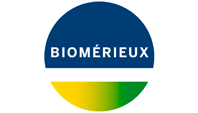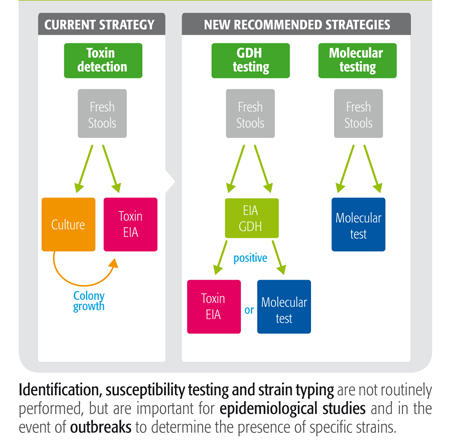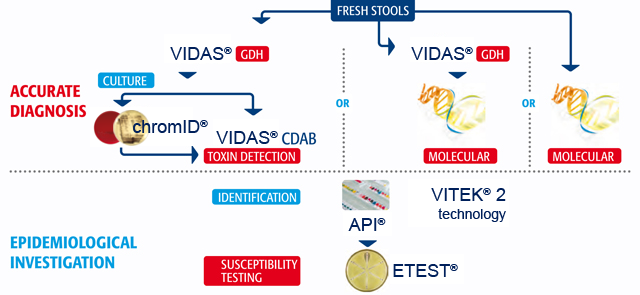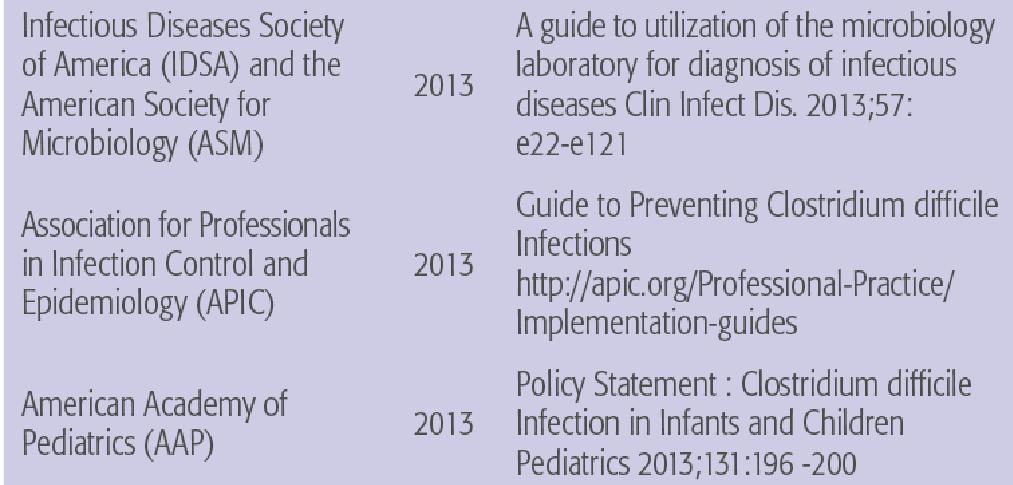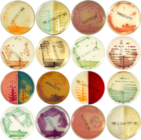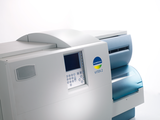VIDAS® C. difficile panel
Rapid identification of C. difficile infection
The VIDAS® C. difficile panel includes two complementary tests used as an aid in the diagnosis of C. difficile infection.
- Automated and easy to use for rapid results
- Simplifies the diagnosis step
- Flexible solution adapted to small or large volumes
- Helps you rule-out negative patients in just 50 minutes (VIDAS® GDH)
Do you need more information
VIDAS® C. difficile GDH is a qualitative test that detects the C. difficile antigen, glutamate dehydrogenase (GDH), in stool specimens to screen patients suspected of having a C. difficile infection. It is used in conjunction with VIDAS® C. difficile Toxin A & B as part of a two-step algorithm. Both tests are based on the ELFA (Enzyme-Linked Fluorescent Assay) technique.
The VIDAS® C. difficile panel will rapidly provide the information needed to help you identify and contain the spread of the infection¹. This will help decrease patient morbidity and mortality rates, and reduce the economic and human burden of C. difficile on hospitals and healthcare systems².
Testing strategies
According to the new guidelines*, positive GDH results should be tested for C. difficile toxins A & B to confirm the presence of a C difficile infection.
* See RESOURCES TAB
Reliability
The VIDAS® C. difficile panel will help you improve patient management :
- VIDAS® C. difficile GDH: high negative predictive value (NPV)* which ensures you confidently rule out negative results
|
VIDAS® GDH Performance versus CCFA culture medium
|
VIDAS® GDH Performance versus chromID C. difficile | |
|---|---|---|
| NPV | 99.1% [98.5 – 99.5]% | 98.3% [97.5 – 98.9]% |
| Sensitivity | 95.8% [92.8 – 97.7]% | 92.9% [89.6 – 95.3]% |
| Specificity | 90.0% [88.4 – 91.4]% | 91.8% [90.3 – 93.1]% |
- VIDAS® C. difficile Toxin A & B: high specificity* to avoid over-diagnosis
* See package insert for performance details
vidas_c.png
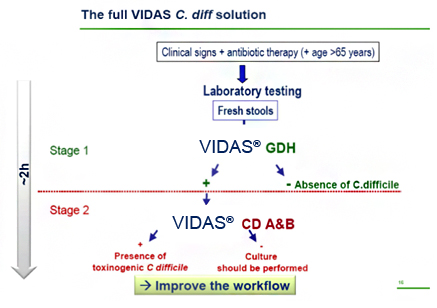
Solution benefits
- Automated and easy-to-use: the VIDAS® immunoanalyzer family is recognized worldwide for its flexibility, ease-of-use and seamless fit into lab workflow
- Short time to result: only 50 minutes for VIDAS® C. difficile GDH and 75 minutes for VIDAS® C. difficile Toxin A & B
- Compliant with new guidelines*
- Cost-effectiveness:
- Reduction of unnecessary tests for better cost control
- Single-test format adapted to low or high volume testing for sporadic or epidemic outbreaks
- Tracking of epidemiological trends: keep record of all processed specimens
* See RESOURCES
bioMérieux’s C. difficile global offer
bioMérieux offers the market’s first complete C. difficile solution:
|
Method |
Product Name |
Reference |
|---|---|---|
|
Screening |
VIDAS® GDH |
Ref. 30125 |
|
Toxin detection |
VIDAS® C. difficile Toxin A&B |
Ref. 30118 |
|
Culture |
chromID® C. difficile agar |
Ref. 43871 |
|
Identification |
VITEK® 2 ANC card |
Ref. 21347 |
|
Susceptibility testing |
ATB™ ANA2 |
Ref. 142691 |
|
Surveillance |
VIGIguard™ |
» Find out more about bioMérieux’s C. difficile Global Solution
References
(2) Siegel JD, Rhinehart E, Jackson M, Chiarello L, and the Healthcare Infection Control Practices Advisory Committee, 2007 Guideline for Isolation Precautions: Preventing Transmission of Infectious Agents in Healthcare Settings.
| VIDAS® C. difficile GDH |
VIDAS® C. difficile Toxin A & B |
|
|---|---|---|
| Reference | 30125 | 30118 |
| Tests/kit | 60 | 60 |
| Time to result | 50 minutes | 75 minutes |
| Sample type | Fecal specimen | Fecal specimen |
| Stool sample volume Sample volume after pre-treatment |
200 µL 300 µL |
200 µL 300 µL |
| Calibration frequency | 28 days | 14 days |
Find more technical details on www.myvidas.com.
Consult your local bioMérieux representative for product availability in your country.
Related Publications
ECCMID 2014
J. Van Broeck, E. Ngyuvula Mantu, K. Soumillion, M. Delmée . Evaluation of the impact of freezing on positive Clostridium difficile stools using VIDAS® GDH & VIDAS® CD toxins A/B, Liaison GDH, Liaison toxins A&B and C. DIF QUIK CHEK Complete®.
ECCMID 2013 Abstract R2753
L. De Cooman, S. Drieghe, I. Leroux-Roels, G.Glaeys. J. Boelens. Evaluation of the VIDAS® Gultamase Dehydrogenase Test (bioMérieux) for algorithm-based Clostridium difficile testing.
ECCMID 2013 Poster P187
C.Eckert, O. Said, C. Rambaud, N. Poccardi, B. Burghoffer, V. Lalande, F. Barbut. Comparison of the VIDAS® C. difficile GDH and the GDH component of the C. diff Quik Chek Complete for detection of Clostridium difficile in stools.
ECCMID 2013 Poster 1872
D. Achleiter, A. Wutscher, M. Hell. Evaluation of the new VIDAS GDH (ELFA) Test and VIDAS Clostridium difficile Toxin A&B Test compared to a 3-Step Toxin B-PCR based-algorithm at a University Hospital.
ECCMID 2012 P2266
Davies, K. A., Bosomworth, C. E., Carricajo, A., Adam, T. and Wilcox, M.H. Comparison of VIDAS® GDH automated immunoassay with Cepheid GeneXpert® C. difficile PCR assay and an in-house PCR assay for GluD, for the detection of C. difficile in faecal samples.
Guidelines
New C. difficile testing algorithm guidelines recommend the use of a two-step protocol starting with a GDH enzyme immunoassay (EIA) followed by a sensitive toxin EIA to confirm positive results. A culture test then establishes sensitivity for results similar to the “gold standard” culture + toxin test.
The importance of quick C. Difficile testing
Here are just a few of the reasons why it’s important to be able to rapidly test for C. difficile:
- Clostridium difficile causes about 15-25% of antibiotic-associated cases of diarrhea1
- Prevalence: 13.1/1000 patients in the US2
- Overall incidence is on the rise: In Saxony, Germany, the incidence of CDI increased from 1.7 to 3.8 cases per 100,000 people in 2002 to 14.8 cases per 100,000 people in 20063 becoming higher than MRSA
- Elderly and immunocompromized patients are especially at risk of contracting C. difficile and becoming severely ill1
- Hyper-virulent strains are on the rise1
- Severe outbreaks, increased morbidity and mortality are rising at alarming rates (Mortality (US): 6-15%)4
- Economic burden: $3.2 M for the US and 3 billion euros in Europe5
1. Bartlett JG. Clinical practice. Antibiotic-associated diarrhea. N Engl J Med 2002;346:334-349
http://www.cdc.gov/HAI/organisms/cdiff/Cdiff_faqs_HCP.html#a1
2. Jarvis WR. et al.: National point prevalence of Clostridium difficile in US health care facility inpatients. AJIC 2009 37:263-270
3. Rupnik M. et al.: Clostridium difficile infection: new developments in epidemiology and pathogenesis. Nature reviews microbiology. 2009;7:10.1038/nrmicro2164.
4. Bartlett JG. et al. Clinical recognition and diagnosis of Clostridium difficile infection. Clin Infect Dis. 2008; 46:S12-18.
5. Barbut F. et al. A European survey of diagnostic methods and testing protocols for Clostridium difficile. ESCMID study group report. Clin Microbiol Infect. 2003;9:989-996
